Alcázar Tour
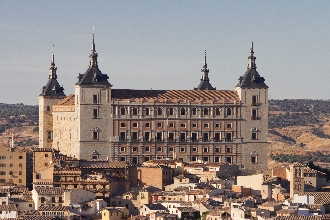
The Army Museum has highlighted the value of a number of unique spaces the Alcázar keeps in its inside, so that the general public can visit and know them in situ. Such spaces, which make up what we have called the “Alcázar Tour”, are located on different floors of the building and are marked in purple color on the location plan.
In each one of these spaces, the visitors will find an explanatory text that will give them an insight of its history and the function it used to have. The Imperial Chapel, because of its size and architectonical significance, has been included as an exhibition space.
The Alcázar Tour is composed of the following spaces:
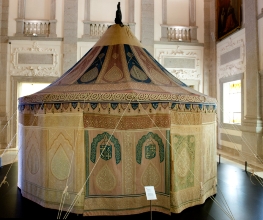
Within the Imperial Chapel, located on the mezzanine 6B, we can find the biggest piece kept by the Army Museum. It is the Indo-Portuguese Tent, usually referred to as the “Tent of Charles V”. This space contextualizes pieces belonging to the Habsburg Dynasty; mainly to Charles I (Charles V, Holy Roman Emperor, was crowned as king of Spain under the name of Charles I) and Philip II.

The commonly called “Colonel Moscardó’s Office” corresponds, historically, to the Infantry, Cavalry and Quartermaster Academy Director’s office, since this Academy used to be located in the Alcázar de Toledo. The office was being used by Colonel Moscardó, military commander of Toledo and head of the Fitness School, when the forces loyal to the Republican Government laid siege to the Alcázar on July 21, 1936. The siege ran on until September 27 of that year.
It shows the condition of the office after the siege, various pieces of furniture, the telephones, pictures of the historic event and two paintings of Colonel Moscardó and his son Luis.
As a revealing document of the historic episode that was the phone conversation between Colonel Moscardó, his son Luis and the lawyer Cándido Cabello, commander of the Republican militia in Toledo, the visitor will also find a copy of the operations journal and a facsimile of the page dated on July 23. That day, at ten in the morning, the Alcázar received a phone call from Toledo’s Provincial Council.
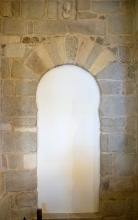
This gateway is a Moorish arch that used to be a part of the monumental access to the Alcázar’s fortified complex during the Umayyad period. Its construction began, most likely, in the tenth century, when the Caliph Abd-Ar-Rahman III ordered to erect a solid alcázar at Toledo.
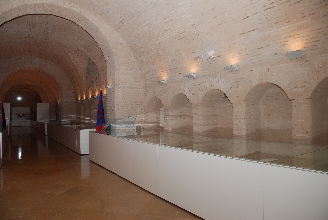
The Alcázar underwent a series of improvements launched by Charles V and continued by his son Philip II. The Old Stables predate these improvements, which did affect, though, the so called New Stables.serie de reformas emprendidas por Carlos V y continuadas por su hijo Felipe II. Las Caballerizas Viejas son anteriores a dichas reformas que sí afectaron a las llamadas Caballerizas Nuevas.
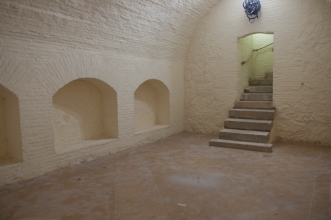
It is a space where water and wine were kept for chilling. The traditional belief says that Doña Blanca of Bourbon was locked up here in the fourteenth century.
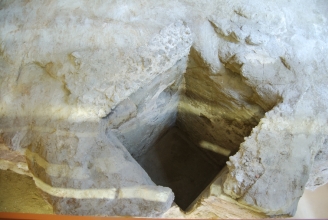
These structures collected rainwater from the upper floor. Then, the water flowed through gutters to supply the kitchens and the stables.

The remains of some of the military and civilians who defended the Alcázar during the siege laid by Republican forces between July 21 and September 27, 1936, were buried in this crypt
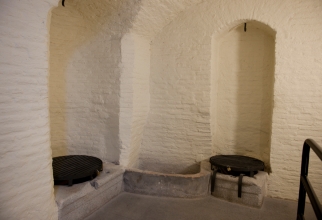
The Aljibe (reservoir) is a fifteen century’s brick construction with rectangular ground plant that used to be the main water storage in the Alcázar. The water came from the Tajo River
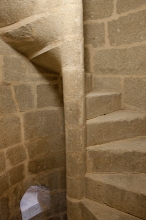
These interior stairs called “Caracoles Secretos” (Secret Snails) were exclusively used by the monarch and communicated the so called “king room” with the “royal dressing room” located on the ambulatory.
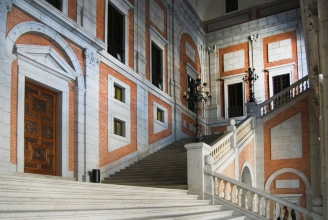
It is situated at the foot of the courtyard front. This staircase was designed by architect Francisco de Villalpando after the Renaissance style and was completed during the reign of Philip II. It too had to be rebuilt after the Spanish Civil War. The reconstruction followed the Renaissance traces and restored its original granite steps.
